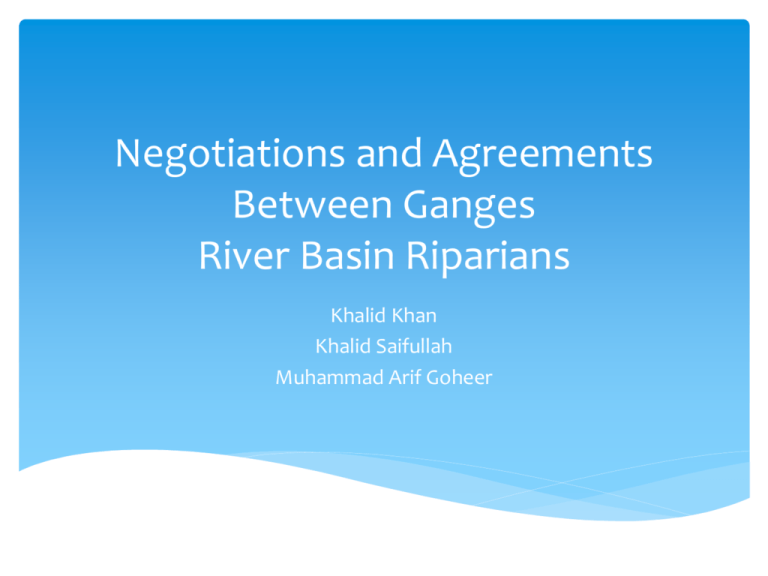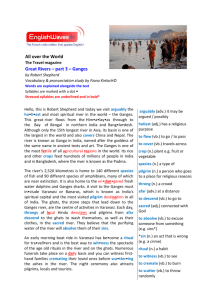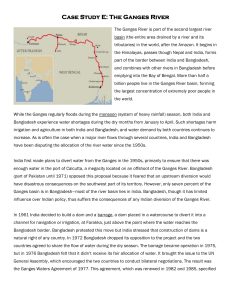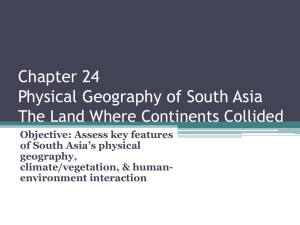Negotiations and Agreements Between Ganges River Basin Riparians
advertisement

Negotiations and Agreements Between Ganges River Basin Riparians Khalid Khan Khalid Saifullah Muhammad Arif Goheer Features of the Watershed Total Watershed Population: 200 million Total Watershed Area: 1,634,900 km2 Land Use: agricultural cropland, pasture, industrial use, urban high density, religious/cultural sites Important Uses of Water: Agriculture or Irrigation, Domestic/Urban Supply, Hydropower Generation Hydrologic and Geopolitical Background Dramatic seasonal variations in rainfall Problems developed between India and Bangladesh The headwaters of the Ganges and its tributaries lie primarily in Nepal and India, where snow and rainfall are heaviest Newer treaty is unlikely to make any substantial contribution to alleviate water scarcity during the dry season in southwestern Bangladesh The Problem India, as the upper riparian, developed plans for water diversions for irrigation, navigability, and water supply interests. Bangladesh, has interests in protecting the historic flow of the river for its own downstream uses. This potential clash set the stage for attempts at conflict management. Attempts at Conflict Management 1960–1970 – a series of meetings were held but were not successful because of lack and inefficient data provided by Pakistan and other technical facts. Pakistan’s goal: Substantive talks on the framework for a settlement for equitable sharing of the Ganges waters between the two countries." Pakistan’s Proposal Construction and maintenance of such works, if any, in India as may be necessary in connection with the construction of the Ganges Barrage in Pakistan ; Setting up of a permanent Ganges Commission to implement the agreement; Machinery and procedure for settlement of differences and disputes consistent with international usages. India’s Recommendations The point of delivery of supplies to Pakistan of such quantum of water as may be agreed upon will be at Farakka Constitution of a body consisting of one representative from each of the two countries for ensuring delivery of agreed supplies at Farakka is acceptable in principle A meeting would be held in three to six months’ time at a level to be agreed to by the two governments to consider the quantum of water to be supplied to Pakistan at Farakka and other unresolved issues relating thereto and to eastern rivers which have been subject matter of discussions in these series of talks. Outcomes Ganges Water Agreement covers; Sharing the waters of the Ganges at Farakka. Finding a long term solution for augmentation of the dry season flows of the Ganges. Approaches There were two general approaches to augmenting Ganges Flow presented to the Commission, which defined the negotiating stance for years: Augmentation through storage facilities within the Ganges basin, proposed by Bangladesh Augmentation through diversion of water from the Brahmaputra to the Ganges at Farakka by a link canal, proposed by India. Bangladesh Position There is adequate storage potential of monsoon flow in the Ganges Basin for Indian needs; There is additional storage along the headwaters of the Ganges tributaries in Nepal , and that country might be approached for participation; A feeder canal from the Brahmaputra to the Ganges is both unnecessary and would have detrimental effects within Bangladesh , not least of which would be massive population resettlement; Indian needs would be better met through amending the pattern of diversion of Ganges water into the Bhagirathi Hooghly, and constructing a navigation link from Calcutta to the sea via Sunderban. India Position Additional storage possibilities in India are limited, and not sufficient to meet Indian development needs; The most viable option both to supplement the low flow of the Ganges, and for regional development, is a link canal and storage facilities on the Brahmaputra, to be developed in stages for mutual benefit; Approaching Nepal or other third countries is beyond the scope of the Commission, as is discussing amending the pattern of diversion into the Bhagirathi Hooghly; Constructing a separate navigation canal is not connected to the question of optimum development of water resources in the region. Diplomatic Techniques Role of Third Party In January 1976, Bangladesh lodged a formal protest against India with the General Assembly of the United Nations which, on November 26, 1976, encouraging the parties to meet urgently at the ministerial level for negotiations, "with a view to arriving at a fair and expeditious settlement." At an April 18, 1977 meeting, an understanding was reached on fundamental issues, which culminated in the signing of the Ganges Waters Agreement Strategic Approach In December 1996, a new treaty was signed between the two riparians, based generally on the 1985 accord, which delineates a flow regime under varying conditions. The most notable change in the 1996 Ganges River Treaty is the establishment of a new formula for the distribution of Ganges waters from January 1st to May 31st, the region's dry season, at Farraka Barrage. The following schedule is to be respected with regards to 10day period flows . If flows at Farakka Barrage should fall below 50,000 cusecs, the two governments will meet together to consult as to the appropriate actions taking into consideration "principles of equity, fair play and no harm to either party." Ganges River’s Allocations Flow Amount India Bangladesh <70,000 cusecs 50% 50% 70,000 - 75,000 cusecs Balance of flow 35,000 cusecs




